Hi Everyone!
On this page you will find some material about Lesson 2. Read through the material below, watch the videos, and follow up with your instructor if you have questions.
Lesson 2: 2-D Systems of Equations & Substitution and Elimination
Table of Contents
Resources
In this section you will find some important information about the specific resources related to this lesson:
- the learning outcomes,
- the section in the textbook,
- the WeBWorK homework sets,
- a link to the pdf of the lesson notes,
- a link to a video lesson.
Learning Outcomes.
- Know what it means to be a solution to a system of equations.
- Know how to verify a proposed solution.
- Explain the graphical approach to solving a 2-D linear system and explain each case.
- Explain the algebraic methods to solving a 2-D linear system.
- Use creativity to solve problems.
- Communicate effectively using written and oral means using logical thinking.
Topic. This lesson covers
Section 3.2: Solving Systems of Linear Equations by the Substitution Method,
Section 3.3: Solving Systems of Linear Equations by the Addition Method,
Section 3.4: Applications of Systems of Linear Equations in Two Variables.
WeBWorK. There is one WeBWorK assignment on today’s material:
LinearSystems
Lesson Notes.
Video Lesson.
Video Lesson 2 (based on Lesson 2 Notes)
Warmup Questions
These are questions on fundamental concepts that you need to know before you can embark on this lesson. Don’t skip them! Take your time to do them, and check your answer by clicking on the “Show Answer” tab.
Warmup Question 1
Solve for $x$
$$3(x-1)-5x=10.$$
Show Answer 1
\begin{align*} 3(x-1)-5x&=10\\ x-3-5x&=10\\ -2x&=13\\ x&=-\dfrac{13}{2}\end{align*}
Quick Intro
This is like a mini-lesson with an overview of the main objects of study. It will often contain a list of key words, definitions and properties – all that is new in this lesson. We will use this opportunity to make connections with other concepts. It can be also used as a review of the lesson.
A Quick Intro to 2-D Systems of Equations & Substitution and Elimination
Key Words. Linear equation, system, solution, substitution, elimination, graph.
In a system of two linear equations in two variables, we consider two linear equations $$\begin{cases}Ax+By=C\\ Dx+Ey=F\end{cases}$$
Graphically speaking, this system consists of two lines.
$\bigstar$ A solution $(x,y)$ to the system must satisfy all equations at the same time. This means that the solution $(x,y)$ belongs to each line, so it is in the intersection of the two lines. This is the graphing method for obtaining the solution.
$\bigstar$ How many solutions can there be? There are three possible situations:
- the two lines intersect at one point; in this case, the system has only one solution, which is the intersection point.
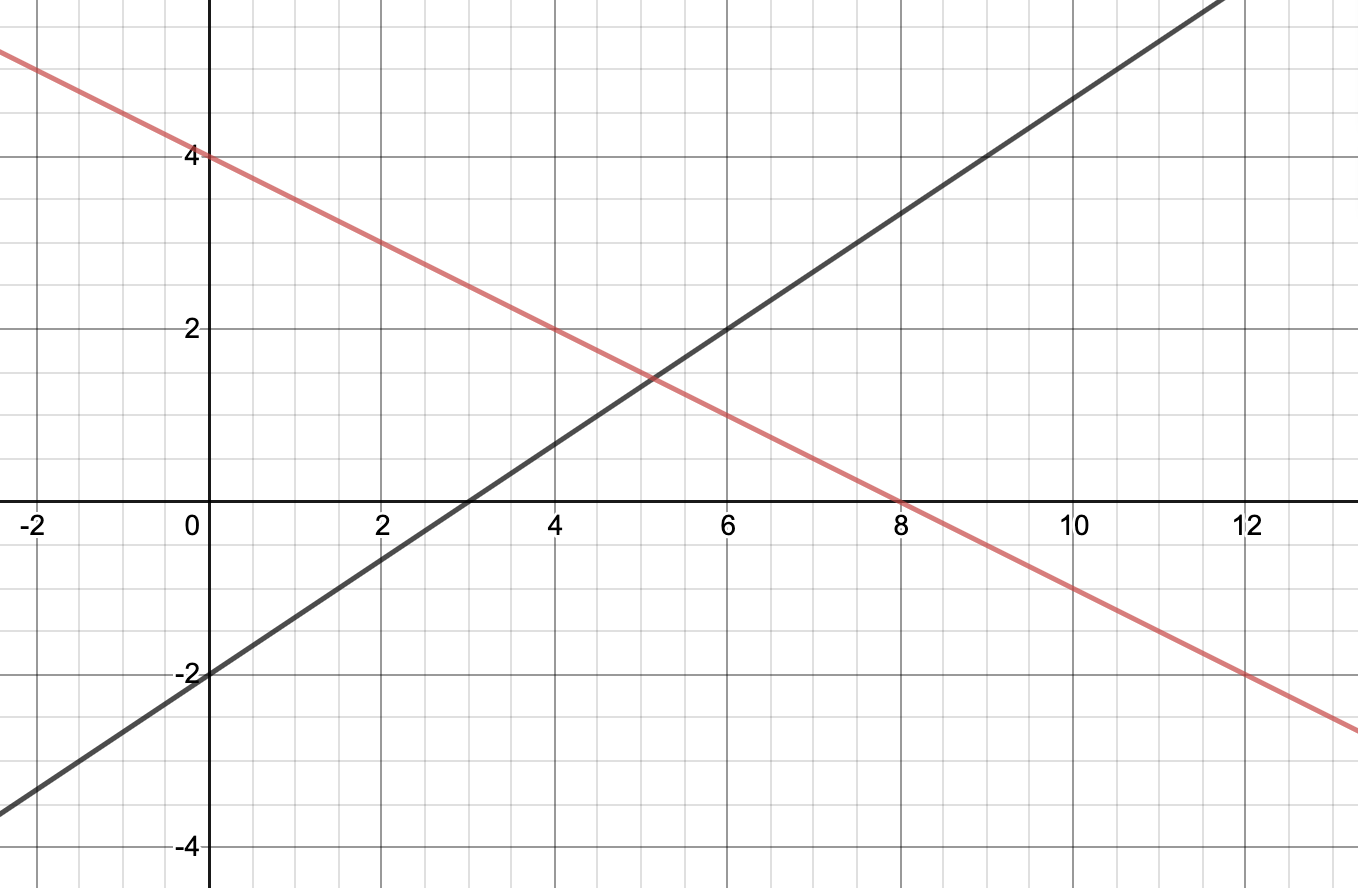
- the two lines are parallel; in this case, the system has no solution.

- the two lines coincide; in this case, the system has infinitely many solutions.
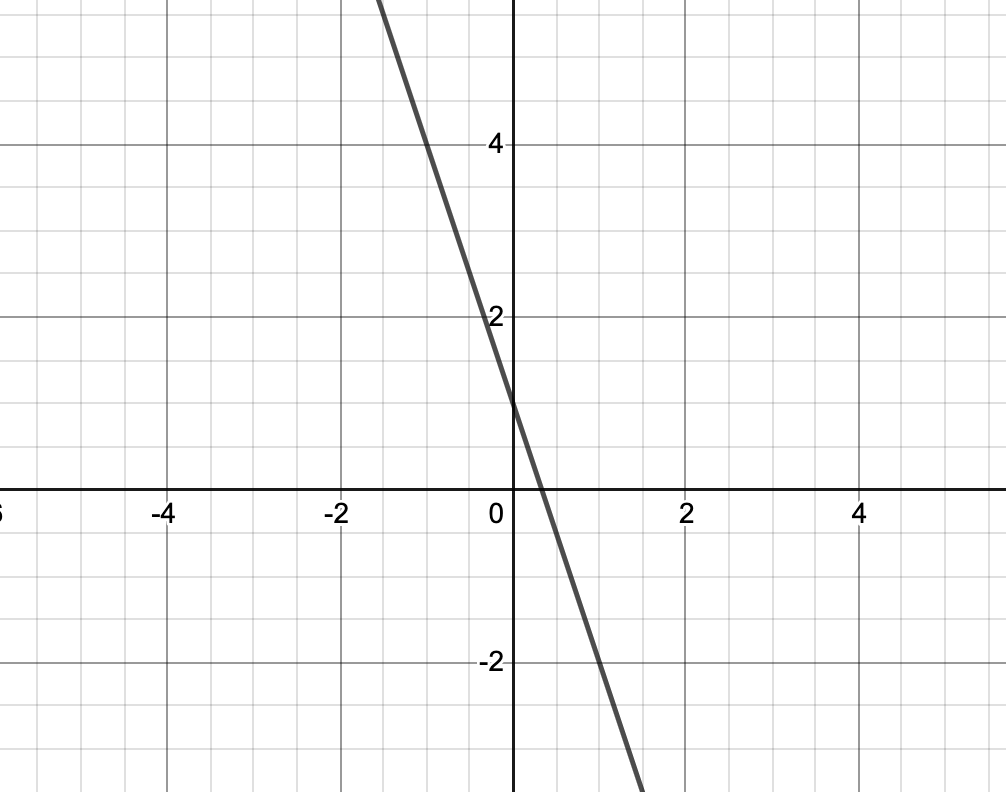
$\bigstar$ There are two algebraic methods for solving a system of two linear equations.
$\bullet$ Substitution Method: this method consists of isolating one of the variables from one of the equations, and substituting it into the other equation.
$\bullet$ Addition Method: this method consists in multiplying each equation by a number (if necessary) so that when the two equations are added the resulting equation depends on one variable only.
Video Lesson
Many times the mini-lesson will not be enough for you to start working on the problems. You need to see someone explaining the material to you. In the video you will find a variety of examples, solved step-by-step – starting from a simple one to a more complex one. Feel free to play them as many times as you need. Pause, rewind, replay, stop… follow your pace!
Video Lesson
A description of the video
In the video you will see the following system $$\begin{cases}2x-y=1\\3x+y=4\end{cases}$$
Try Questions
Now that you have read the material and watched the video, it is your turn to put in practice what you have learned. We encourage you to try the Try Questions on your own. When you are done, click on the “Show answer” tab to see if you got the correct answer.
Try Question 1
Consider the system $$\begin{cases}2x-3y=6\\x+2y=8\end{cases}.$$
(a) Is $(6,2)$ a solution?
(b) Is $(6,-2)$ a solution?
(c) Is $(0,-2)$ a solution?
(d) Is $(8,0)$ a solution?
Show Answer 1
(a) $(6,2)$
\begin{align*} 2x-3y &\stackrel{?}{=}6\\ 2\cdot 6 – 3 \cdot 2 & \stackrel{?}{=}6\\ 6 &\stackrel{\checkmark}{=}6\qquad\text{True}\\ x+2y&\stackrel{?}{=}8\\6 + 2 \cdot 2 &\stackrel{?}{=}6\\10& \stackrel{\times}{=}6\qquad\text{False}\end{align*}
The point $(6,2)$ belongs to the first line, but not to the second line, so it is not a solution. See the graph below.
(b) $(6,-2)$
\begin{align*}2x-3y &\stackrel{?}{=}6\\ 2\cdot 6 – 3 (-2)& \stackrel{?}{=}6 \\ 18 &\stackrel{\times}{=}6\qquad\text{False}\end{align*}
The point $(6,-2)$ does not belong to the first line, so it is not a solution. See the graph below.
(c) $(0,-2)$
\begin{align*} 2x-3y & \stackrel{?}{=}6 \\2\cdot 0 – 3 (-2)& \stackrel{?}{=}6\\ 6 & \stackrel{\checkmark}{=}6\qquad\text{True}\end{align*}
\begin{align*} x+2y&\stackrel{?}{=}8\\ 0 +2(- 2) & \stackrel{?}{=}6\\-4 &\stackrel{\times}{=}6\qquad\text{False}\end{align*}
The point $(0,-2)$ belongs to the first line, but not to the second line, so it is not a solution. See the graph below.
(d) $(8,0)$
\begin{align*}2x-3y&\stackrel{?}{=}6\\2\cdot 8 – 3 \cdot 0& \stackrel{?}{=}6\\16 &\stackrel{\times}{=}6\qquad\text{False}\end{align*}
The point $(8,0)$ does not belong to the first line, so it is not a solution. See the graph below.
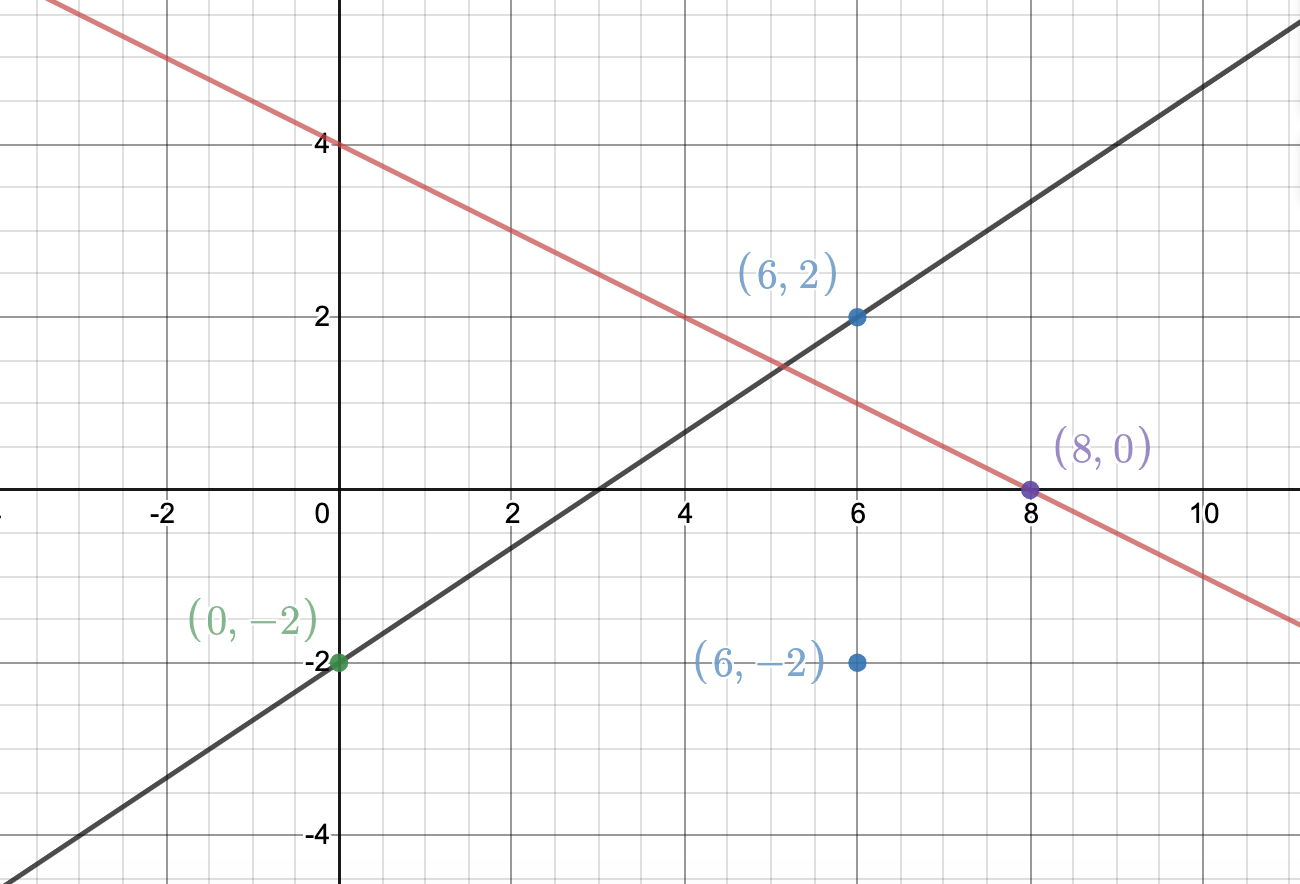
The graph shows two lines. The black one represents $2x-3y=6$. The red one represents $x+2y=8$. There are four labelled points: $(0,-2)$, $(6,2)$, $(8,0)$ and $(6,-2)$. The points $(0,-2)$ and $(6,2)$ are on the black line, but not on the red line. The point $(8,0)$ is on the red line, but not on the black line. The $(6,-2)$ is not on either line.
Try Question 2
Solve $$\begin{cases}2x-3y=6\\x+2y=8\end{cases}$$ by using the Substitution Method.
Show Answer 2
$$\begin{cases}2x-3y=6\\x+2y=8\end{cases}$$
$$\begin{cases}2x-3y=6\\x=-2y+8\end{cases}$$
By substituting $x=-2y+8$ into $2x-3y=6$, we obtain
\begin{align*} 2(-2y+8)-3y &=6\\ -4y+16-3y&=6\\-7y& = -10\\y& = \dfrac{10}{7}.\end{align*}
By plugging $y = \dfrac{10}{7}$ into $x=-2y+8$, we obtain
\begin{align*}x&= -2\cdot\dfrac{10}{7}+8\\& = -\dfrac{20}{7}+8 \\&= \dfrac{36}{7}.\end{align*}
The solution set is $\left\{\left(\dfrac{36}{7},\dfrac{10}{7}\right)\right\}$.
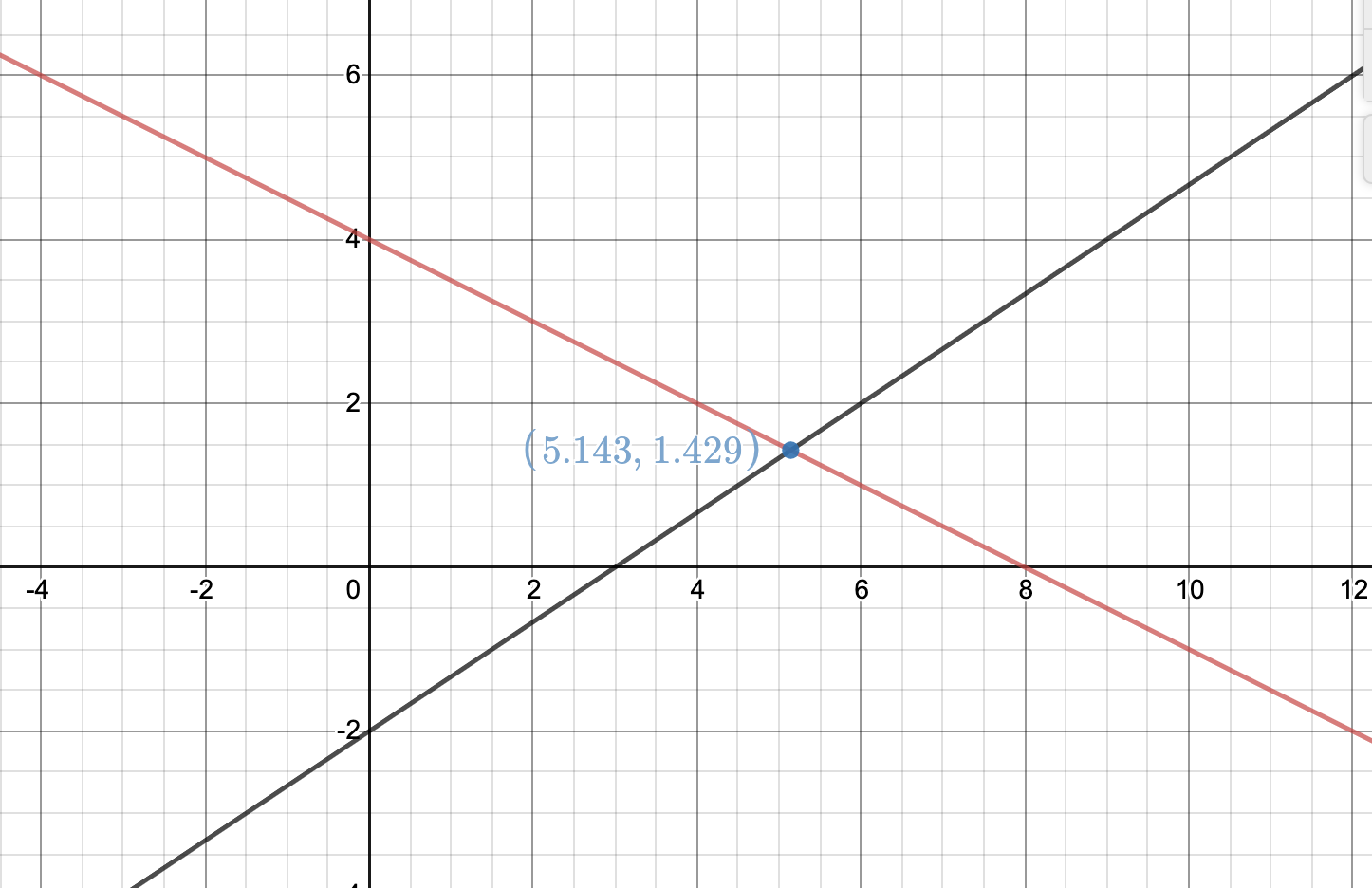
Try Question 3
Solve $$\begin{cases}2x-3y=6\\4x-6y=7\end{cases}$$ by using the Addition Method.
Show Answer 3
$$\begin{cases}2x-3y=6\\4x-6y=7\end{cases}$$
Multiplying the first equation by $-2$ gives
$$\begin{cases}-4x+6y=-12\\4x-6y=7\end{cases}$$
Adding the two equations gives
$$\begin{cases}0=-5.\end{cases}$$
which is not possible. So the system has no solution. Graphically speaking, the two equations represent parallel lines.
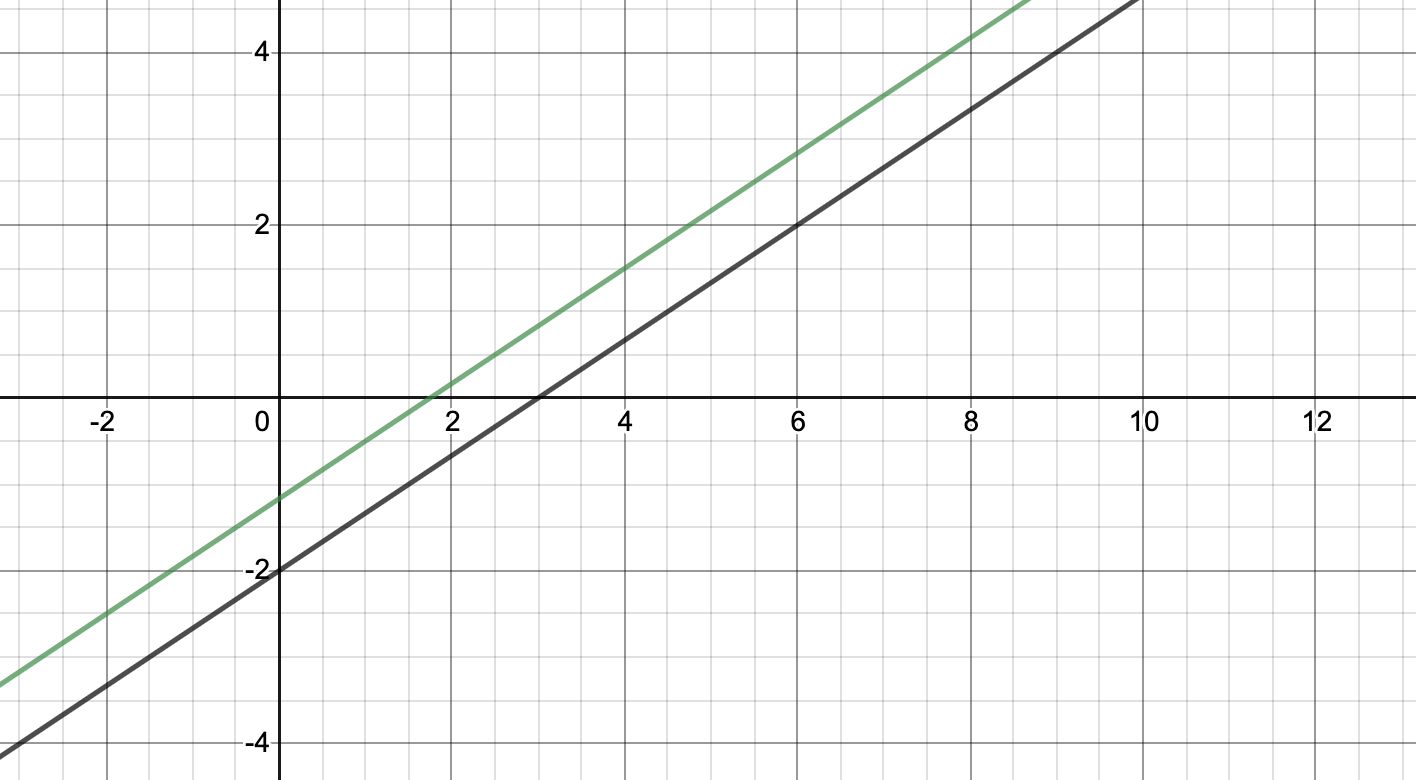
Try Question 4
Solve $$\begin{cases}2x-3y=6\\4x-6y=12\end{cases}.$$
Show Answer 4
$$\begin{cases}2x-3y=6\\4x-6y=12\end{cases}$$
Multiplying the first equation by $2$ gives the second equation. So the two equations represent the same line. The system has infinitely many solutions.

WeBWorK
You should now be ready to start working on the WeBWorK problems. Doing the homework is an essential part of learning. It will help you practice the lesson and reinforce your knowledge.
WeBWorK
It is time to do the homework on WeBWork:
LinearSystems
When you are done, come back to this page for the Exit Questions.
Exit Questions
After doing the WeBWorK problems, come back to this page. The Exit Questions include vocabulary checking and conceptual questions. Knowing the vocabulary accurately is important for us to communicate. You will also find one last problem. All these questions will give you an idea as to whether or not you have mastered the material. Remember: the “Show Answer” tab is there for you to check your work!
Exit Questions
- What does it mean to be a solution to a system of equations?
- How do you check if $(2,3)$ is a solution to your system?
- Explain the graphical approach to solving a 2-D system of equations, and the reasoning behind it. What are this method’s advantages and disadvantages?
- Explain each algebraic approach and describe any advantages or disadvantages.
$\bigstar$ Solve $$\begin{cases}5x+3y=2 \\ 3x-2y=-14 \end{cases}.$$
Show Answer
$$\begin{cases}5x+3y=2 \\ 3x-2y=-14 \end{cases}$$
We use the Addition Method. Multiply the first equation by $-3$ and the second equation by $5$:
$$\begin{cases}-15x-9y=-6 \\ 15x-10y=-70 \end{cases}$$
Adding the two equations gives $-19y = -76$. So $y=4$. Substituting $y=4$ into $5x+3y=2$ yields
\begin{align*} 5x+3\cdot 4 & = 2\\ 5x+12&=2\\5x&=-10\\x&=-2\end{align*}
The solution set is $\{(-2,4)\}$.
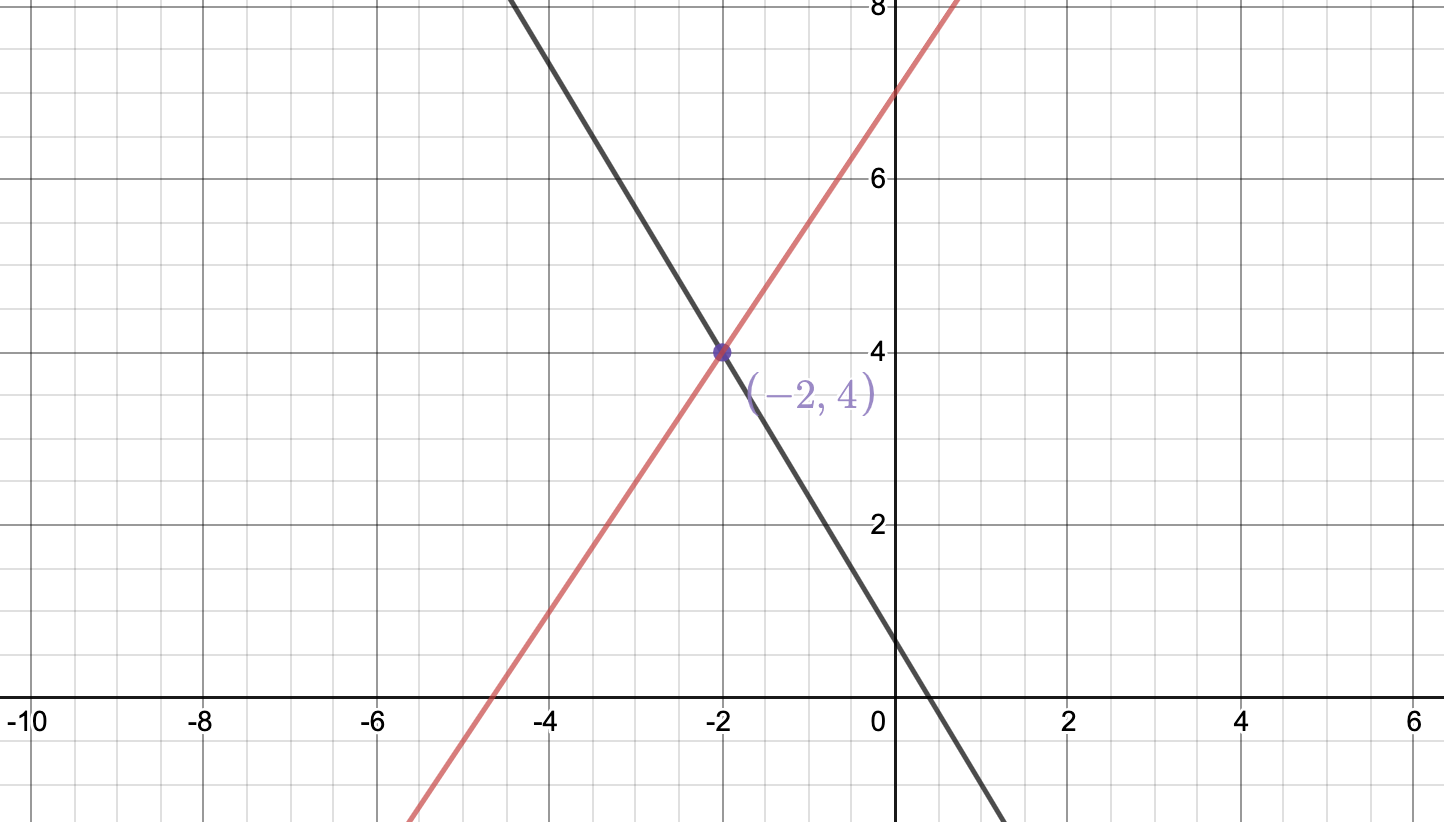
Need more help?
Don’t wait too long to do the following.
- Watch the additional video resources.
- Talk to your instructor.
- Form a study group.
- Visit a tutor. For more information, check the tutoring page.


